Most of us love to see ladybugs in the garden, they are certainly cute. You often see them in the grass or on leaves of plants, but are they eating the grass or plants?
As a general rule ladybugs don’t eat grass or plants. They are predators of plant-eating aphids. However, there’re a couple of plant-eating species of ladybugs you don’t want. The Mexican Bean Beetle and the Squash Beetle both feed on plants and can make a mess of your garden.
The presence of these herbivorous ladybugs in large numbers can leave a scorched earth effect in their wake. Herbivorous tend to belong to the Epilachninae subfamily in the order Coleoptera. These ladybugs eat indiscriminately from the leaves and grass to the tubers of plant-like potatoes.
Keep reading, and let us explore what ladybugs eat and if they are bad for your lawn.
Which Ladybugs Eat Plants?
There are two primary plant-eating ladybugs found commonly in North America:
- The Mexican bean beetle
- The Squash beetle
The Mexican Bean Beetle
The unpopular Mexican bean beetle features eight black dots on each wing against an orange backdrop. These beetles feed primarily on beans and soybean plants, and their larvae are distinct, with spikes protruding off their orange-yellowish bodies.
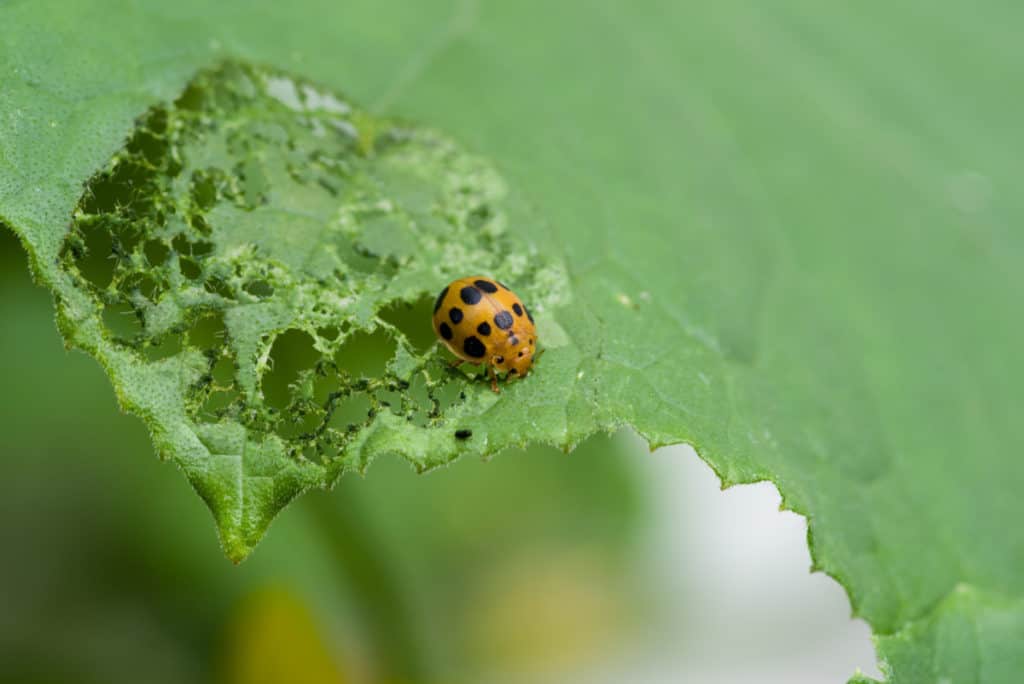
Their preferred host is bean plants, and they will feed on the flowers, leaves, and pods of the plant. However, their focus is mostly on the leaves of the plants, which they damage the most. And without healthy leaves, a plant cannot make food through the process of photosynthesis.
They eat out the lower side of the leaf, leaving a lace-like appearance, and as a result, the plant dies off.
The Squash Beetle
The squash beetle also has a yellow body with black spots but only seven dots on each wing. It loves to feed on squash, cantaloupe and pumpkin. The larvae are also yellowish-orange and have spikes protruding from them as well. However, when it comes to size, the squash beetle is slightly larger compared to the Mexican bean beetle.
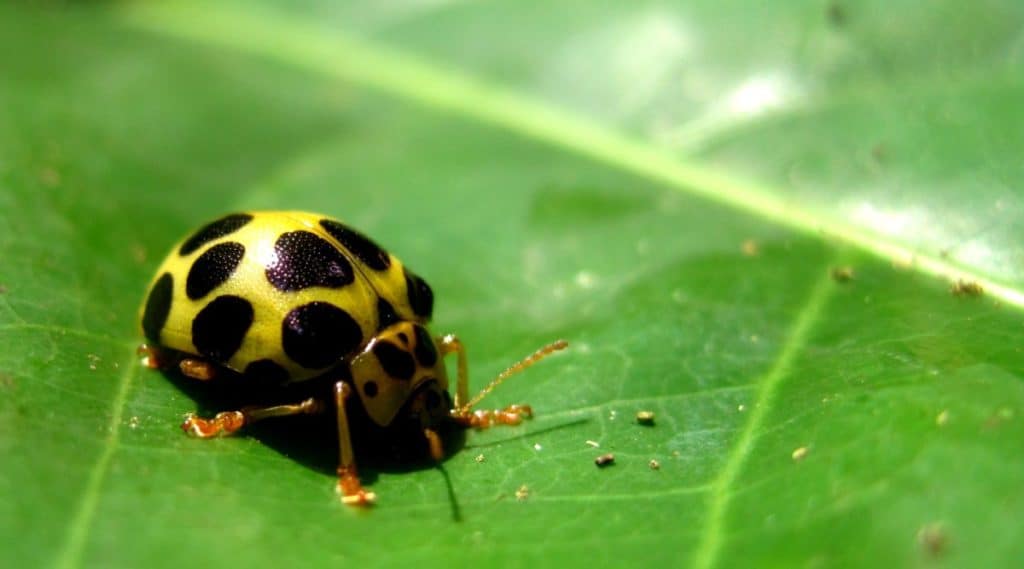
They tend to attack young, flowering plants causing them to wilt and die. These beetles will eat the soft tissue between the leaf’s veins, leaving the veins and the rest of the plant to wilt and die.
If you are trying to identify ladybugs in your garden, then we have an article to will definitely be helpful. The article is called, Ladybug Colors: Your complete Guide.
What Do Ladybugs Eat?
Aphids
Ladybugs mostly feed on aphids. Aphids are small insects that feed on plant sap, which they suck. These little insects are capable of producing live young ones without mating. That results in many insects engulfing your garden within a short period.
Aphids weaken the plants they invade because they suck all the nutrients out of the plant. And because they multiply so fast, they can be very destructive. Having ladybugs in your garden can help to control the aphid populations. In a ladybug’s lifetime, they can eat as much as 5,000 aphids.
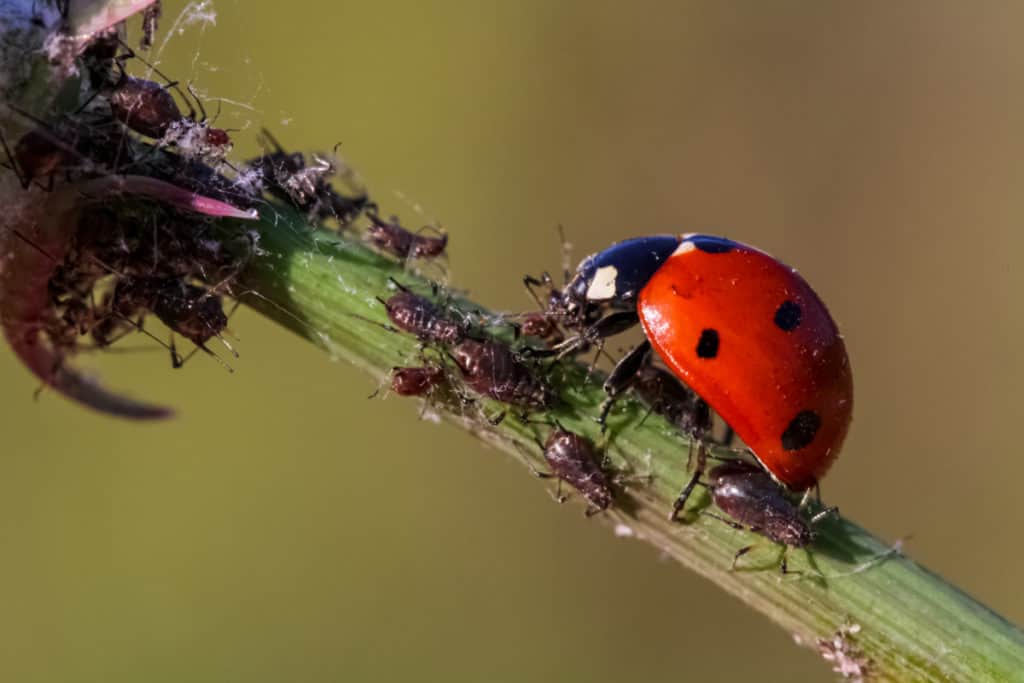
Aphids produce five offspring daily, but ladybugs can eat up to 50 aphids a day. Ladybugs love aphids because they produce honeydew, which is sweet and easy to consume.
In an interesting partnership, aphids have an ally that defends them from attacking ladybugs. We have written a whole article on this battle that is likely going on in your garden every day. The article is called, Do Ladybugs Eat Ants?
Nectar
Ladybugs eat nectar out of necessity to supplement their aphid meals. Brightly colored plants tend to attract the ladybugs, but there are specific flowers that allow the ladybug to enter and gain access to the nutritious nectar.
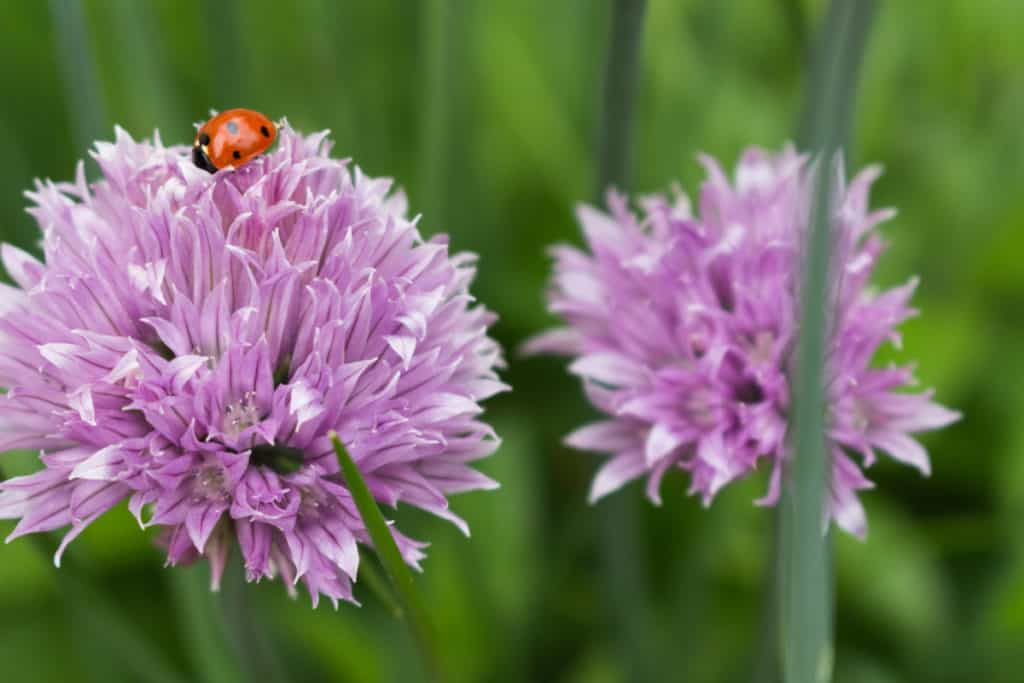
Some of the popular flowers that ladybugs frequent include:
- Calendula
- Chives
- Cosmos
- Angelica
- Cilantro
- Fennel
- Dill
- Marigold
- Statice
- Yarrow
- Feverfew
Their size allows the ladybug to enter all types of flowers, including tubular flowers that are tightly constructed. That allows them to easily access the nectar within.
Pollen
Apart from the nectar from flowers, ladybugs also eat their pollen which is an excellent protein source. Pollen becomes the go-to food supply for these beetles when their favorite aphid population runs low, which happens in the summer months. However, when they recover 2-8 weeks later the ladybugs are sufficiently nourished so they don’t need to eat pollen as much.
Scales
Mealy scales are also soft-bodied insects that make a great meal for ladybugs. They are present on many plants, including shrubs and trees, thus attracting ladybugs to this vegetation. And because scales are sedentary insects, they make a quick and easily available meal for the ladybugs.
The excellent news for ladybugs is that scales become available in the summer months when the aphid population is facing localized extinction. That means that the ladybugs are still able to eat well during the summer months, supplementing their diet of mealy scales with pollen.
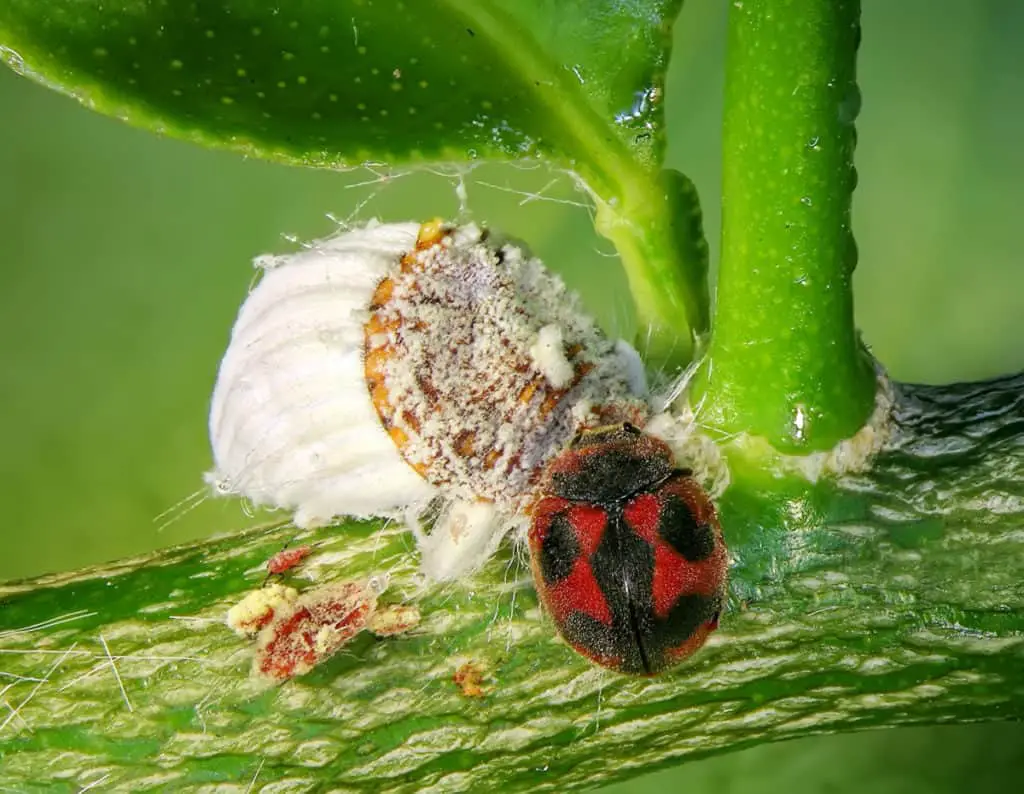
Mites
Mites are also soft-bodied organisms that suck the sap out of plants. They live in colonies and attack the lower part of the leaves, damaging the plant. There are four types of mites, and they are not typically described as insects since they belong to the tick and spider families.
Spider mites are the most common in plants. They suck the sap causing the mesophyll tissue of the plant to collapse. They leave behind small spots where they have been feeding. But ladybugs can effectively wipe out mite populations, but only if you introduce them early before they reproduce too much.
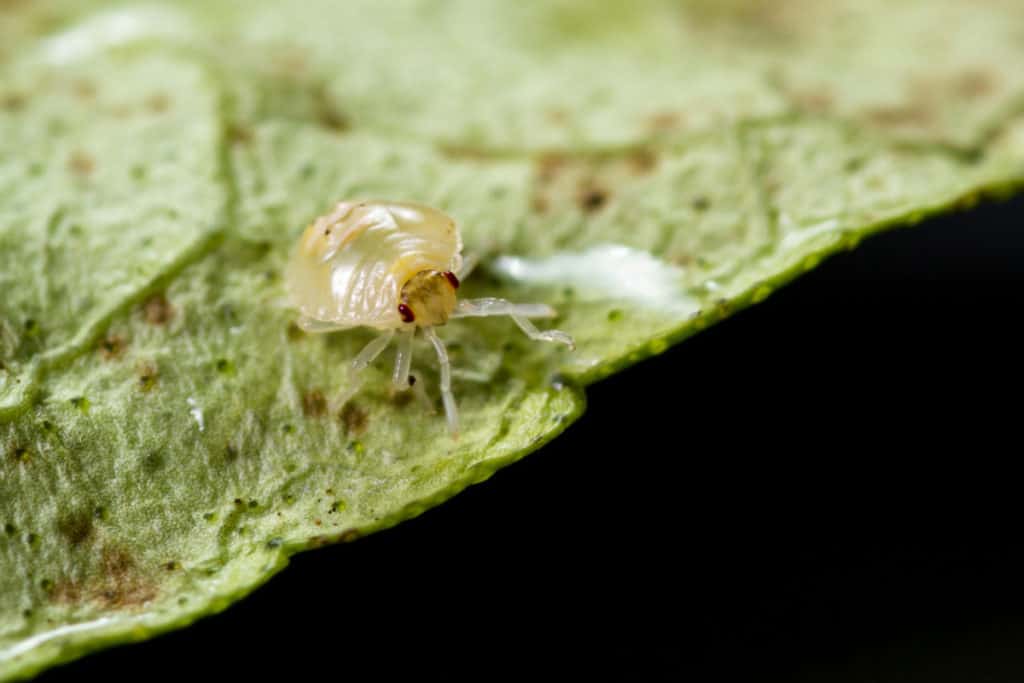
They also make an exceptional substitute meal for the aphids because they can occur during the warm season.
If you are interested we do have a comprehensive guide to everything that ladybugs eat. This is perfect if you are thinking of keeping ladybugs as pets. The article is called, What Do Ladybugs Eat?
Why Ladybugs Are Considered Beneficial For Your Garden?
Ladybugs Are Excellent Pest Control Agents
Pest control is crucial for any garden to thrive. With ladybugs present in your garden, you may not have to invest in commercial pesticides because these insects tend to eat most of the pests. Unlike praying mantis that tend to eat everything in sight, including butterflies and other beneficial insects.
Ladybugs are very precise in their appetite. They love soft-bodied pests like aphids, mealy scales, and mites that are damaging to any green plants.
Interestingly ladybugs don’t track down aphids as you might think. Although it plays a part, their eyesight is not that great. Ladybugs have special sensory abilities located in their antennae and in their legs that together allow them to hone in on their prey.
Ladybugs Are Pollinators
Beetles tend to get pollen stuck on them, and this is the case for ladybugs. That makes them excellent pollinators, and they can get multiple flowers pollinated because they fly far and wide.
Did you know that a ladybug can fly for two hours without stopping? They are prolific long-distance fliers making them the ideal candidates for pollination in agricultural areas.
The ladybug doesn’t mean to pollinate as you would expect of bees. But the pollen that rubs off on its body as it goes about the business of drinking some nectar and perhaps nibbling on the pollen is transferred to other flowers that it visits as it flies around.
If the shell of the ladybug is wet or has droplets, it holds even more pollen, which sticks to it even more firmly. They offer a reasonable level of pollination, although it is not comparable to the work of bees. The plants most likely to be pollinated by ladybugs are those it loves to frequent including the ones on our earlier mentioned.
But also, do not be surprised that the ladybugs in your garden have helped in pollinating the tomatoes, peas, beans, sunflowers, and roses in your garden.
The Wrap Up
Indeed, ladybugs can eat grass and leaves and even bean pods. But these are not the type of ladybugs you want in your garden. So when you see them, get rid of them using pesticides or natural methods like using vinegar.
Also, soapy water drowns the ladybugs and sets your garden free. Just be sure not to get rid of the good fellas in the process. If you are in doubt of the ladybug in your garden, observe two things:
- The pest population in your garden
- Any damage to the leaves, especially if you have beans and squash in your crop.
If the former is low and the latter is non-existent, you have yourself the winning ladybug team. If the reverse is true, you most probably have herbivorous ladybugs in your garden.
Sources
https://en.wikipedia.org/wiki/Coccinellidae
https://entomology.ca.uky.edu/ef105
https://extension.umd.edu/hgic/topics/squash-beetle-vegetables
http://entnemdept.ufl.edu/creatures/veg/bean/MEXICAN_BEAN_BEETLE.HTM
